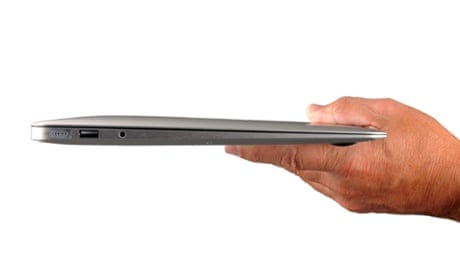Apple has warned that some solid-state drives in its MacBook Air computer range sold between June 2012 and June 2013 could fail abruptly, losing all data.
The company has offered a downloadable software diagnosis and remedy system, though in cases where the problem cannot be fixed it is recommending owners to seek a free replacement.
"Certain" 64GB and 128GB flash storage drives "may fail", Apple says in a support page about the problem. Although it does not specify the manufacturer, a teardown by iFixit last year suggested that it has a Sandforce controller and is made by Toshiba.
To test whether the drive is affected, users should launch the Mac App Store (on the top left-hand menu of the screen) and choose "Updates". If no update called "Firmware Update 1.1" appears, the computer is unaffected.
If the Firmware Update app does appear, install it (which requires being connected to a power source) and run it. The app will check the drive and install new firmware. If the drive suffers from the data-loss problem then it will direct the user to the support page, where they have a number of options to get the drive replaced.
Otherwise it will show a dialog box indicating that the firmware was successfully installed. No other action is required.
The SSD in a MacBook Air cannot be easily replaced by the user - although some sites such as Everymac and iFixit have detailed instructions on how to do it. iFixit, which provides guides on how to replace parts for a huge range of hardware, describes the difficulty of the replacement as "moderate". It requires a special "pentalobe" screwdriver for some of the screws, however.
Otherwise, replacing the drive means a visit to an Apple store or "service provider". Apple says it will cover the costs of repair.
Apple sold 16.7m desktop and laptop computers in the year from July 2012 to June 2013. Around 80% of those, or 13.3m, would have been laptops, but the MacBook Air is only one of a number of different laptops the company offers. It's unclear what proportion of devices might have been affected.
Apple warns owners that if their system is affected by the problem then they should not install operating system updates or new applications - effectively leaving the system untouched apart from some data. Users should make regular backups, and to back up all their data before taking the device for repair, because only the hard drive - and not the data - will be replaced.
The program will last for three years from the sale of the computer.

Comments (…)
Sign in or create your Guardian account to join the discussion